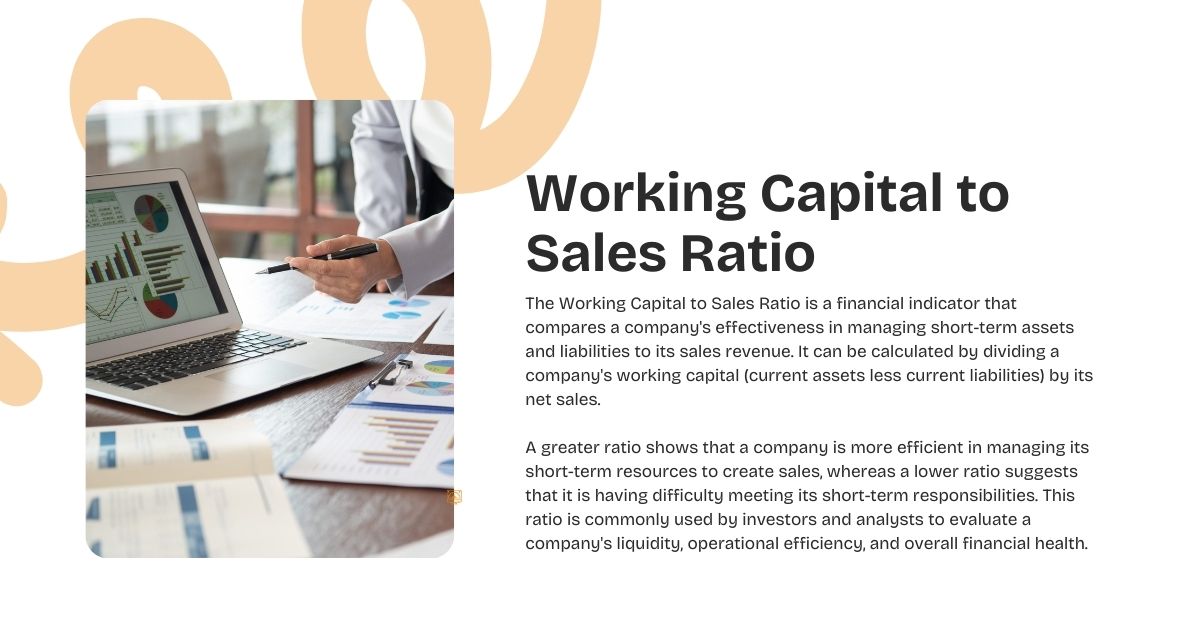If you want to know how efficiently a company makes money, calculate its working capital to sales ratio, also known as the working capital turnover rate. This metric measures how well an organization converts operational dollars to sales. Calculating the ratio can help firms assess their liquidity and manage operations accordingly.
In this post, we’ll explain what a working capital to sales ratio is, how to calculate it with a formula, explore the benefits and drawbacks, and present an example.
What is Working Capital to Sales Ratio?

The Working Capital to Sales Ratio is a financial indicator that compares a company’s effectiveness in managing short-term assets and liabilities to its sales revenue. It can be calculated by dividing a company’s working capital (current assets less current liabilities) by its net sales.
A greater ratio shows that a company is more efficient in managing its short-term resources to create sales, whereas a lower ratio suggests that it is having difficulty meeting its short-term responsibilities. Investors and analysts frequently use this ratio to assess a company’s liquidity, operational effectiveness, and overall financial health.
Working Capital to Sales Ratio Formula
The Working Capital to Sales Ratio is a financial ratio that assesses the effectiveness of a company in utilizing its working capital to generate sales. It is determined by dividing net sales by the average working capital.
Formula
Working Capital to Sales Ratio = Net Sales / Average Working Capital
Where
- Net sales are the total revenue generated by a company from its sales, minus returns, allowances, and discounts.
- Average Working Capital: The average quantity of working capital that the company has at its finger tips during a particular period. It is determined by summing the beginning and ending working capital and dividing the sum by 2.
Interpretation
A higher working capital to sales ratio suggests that a company is effectively utilizing its working capital to generate sales. This implies that the organization is capable of producing a greater number of sales for each dollar allocated to working capital. A lower ratio indicates that the company may be retaining an excessive amount of working capital or is not effectively utilizing its working capital.
For example
The working capital to sales ratio of a company with net sales of $1,000,000 and an average working capital of $200,000 is as follows:
As a result of dividing $1,000,000 by $200,000, the working capital-to-sales ratio is 5.
This implies that the company generates $5 in sales for every dollar invested in working capital.
What is Good Working Capital to Sales Ratio?
The right amount of working capital to sales depends on the business and the market. In general, though, a bigger ratio is thought to be better because it means that a business is using its working capital well to make sales.
A number between 2 and 3 is often used as a guide, but it can change. For example, businesses in retail or manufacturing that need to keep enough product on hand may have lower ratios because they need to keep their inventory turnover high. Companies in the service industry, on the other hand, may have bigger ratios because they don’t need as much inventory.
In the end, the best ratio for a business relies on its unique circumstances and the standards of its industry. To figure out how well a business is doing, you should compare its ratio to those of its competitors and to standards in the same field.
Also Read:
- Price to Sales: A Guide to Valuing Stocks Based on Revenue
- Asset Turnover Ratio: A Step-by-Step Guide to Calculation and Interpretation
Advantages and Disadvantages of Working Capital to Sales Ratio
| Advantage | Disadvantage |
| Easy to calculate and understand It requires only basic financial data: net sales and average working capital. | Doesn’t consider industry-specific factors Different industries have varying optimal ratios, making direct comparisons challenging. |
| Provides a snapshot of working capital efficiency Shows how well a company is using its working capital to generate sales. | May not capture seasonal fluctuations If a company’s working capital needs vary significantly throughout the year, the ratio may not accurately reflect its efficiency. |
| Can be used for benchmarking Allows comparison with industry averages and competitors to assess relative performance. | Doesn’t consider the quality of working capital A high ratio may not indicate efficient use of working capital if a significant portion is tied up in slow-moving inventory or accounts receivable. |
| Can help identify areas for improvement A low ratio may signal the need to reduce excess working capital or improve inventory management. | Doesn’t account for other financial factors The ratio doesn’t consider factors like profitability, debt levels, or growth potential. |
How To Improve Working Capital Ratio?
Managing current assets and bills more efficiently is needed to raise the working capital to sales ratio. Take a look at these strategies:
- Lower the amount of inventory you have by using just-in-time inventory management, getting better at predicting demand, and making sure you buy the right amount of each item to cut down on extra inventory.
- Speed up collections: Set up effective ways to collect on credit, offer rewards for paying early, and think about factoring or discounting debts to get cash faster.
- Talk to your suppliers about extending your payment terms. This will give you more time to get cash from customers before you have to pay your suppliers.
- Optimize cash flow: Keep a close eye on how much cash comes in and goes out, look for ways to cut costs, and spend extra cash to earn interest.
- Use tools like cash flow forecasting and working capital management apps to find ways to improve your working capital management and make smart choices.
Companies can make better use of their working capital, improve their financial health, and support long-term growth by using these tactics.

